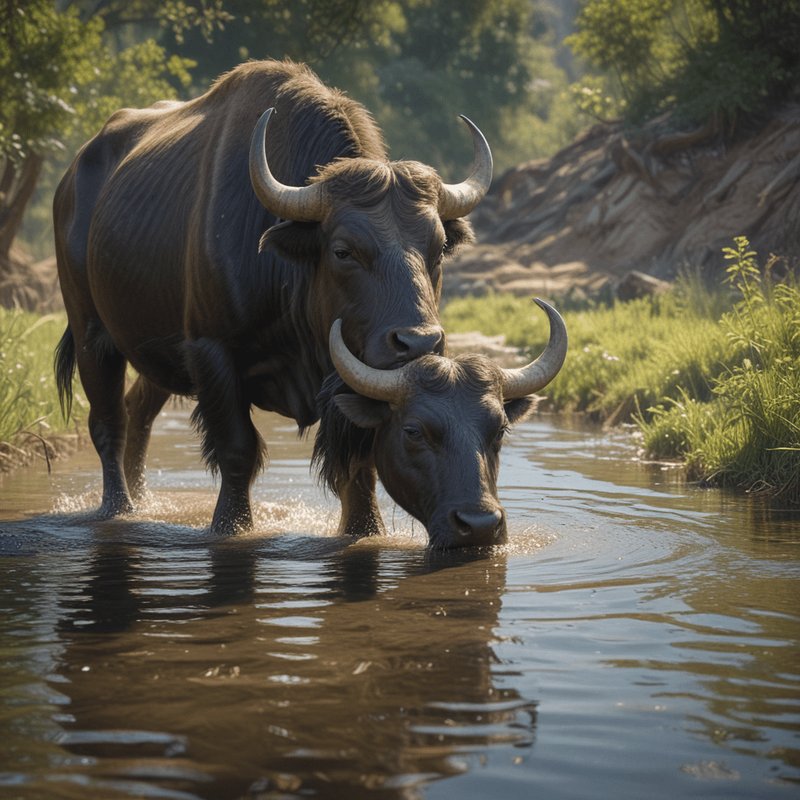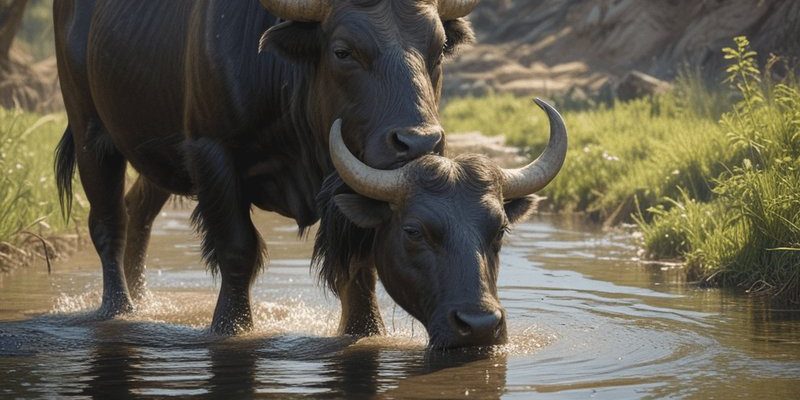
The water buffalo is more than just a big animal; it’s deeply intertwined with human history and agriculture, especially in Asia. From their domestication to their vital role in farming, they’ve been by our side for thousands of years. Let’s dive into how the water buffalo evolved, how they adapted to different environments, and why they matter in today’s world.
Origins and Early Evolution of the Water Buffalo
The story of the water buffalo begins over 5,000 years ago. These animals belong to the *Bovidae* family, which also includes animals like cows and goats. The wild ancestors of water buffalo, particularly the Asian water buffalo (*Bubalus arnee*), roamed through forests and wetlands in Southeast Asia and parts of India. Imagine a time when these great beasts, with their large horns and strong bodies, moved freely in the wild, thick forests around them.
As humans began farming, they saw the value in these animals. The first signs of domestication, which likely happened around 4,000 years ago, show humans started to selectively breed them for specific traits. You might be wondering how this works. Well, just like dog breeds vary widely, so too do different types of buffalo emerged based on what humans needed them for—like strength for plowing fields or size for meat production.
Fast forward a few centuries, and we see two main types of domesticated water buffalo: the river buffalo and the swamp buffalo. Each type adapted to its environment, thanks to both natural selection and human intervention. The river buffalo, with its sleek build, is more commonly found in areas with abundant water, while the swamp buffalo, bulkier and hardy, thrives in harsher conditions.
Domestication and Human Interaction
Once domesticated, the water buffalo became a crucial part of agricultural life in Asia. Imagine rural communities where farmers depended on these animals not just for plowing rice fields but also for providing milk and meat. This dependency created a bond that was crucial for both species’ survival.
Water buffaloes are incredibly versatile. They can thrive on grass and other vegetation, making them efficient foragers. In many cultures, they symbolize wealth and status, and their roles extend beyond just farming. In some regions, water buffalo are involved in traditional festivals, racing events, and even religious ceremonies. They’re more than just livestock; they are part of the cultural fabric.
Additionally, let’s consider their role in the ecosystem. By grazing on grass, they help maintain the landscape. When these animals roam, they also help aerate the soil, making it more fertile for crops. So, in a way, water buffalo are natural farmers. It’s fascinating how they’ve shaped not only agriculture but entire cultures and communities.
Adaptation Through Time
Throughout history, water buffalo have displayed remarkable adaptability. They’ve evolved traits that allow them to thrive in various environments, from the rice paddies of Vietnam to the arid regions in India. Their thick skin and large bodies help them withstand both extreme heat and cold.
Here’s the thing: their adaptability isn’t just physical; it’s behavioral too. Water buffalo are social animals and thrive in herds. This social structure helps them protect one another from predators and aids in raising young. When you see a group of these animals together, you’re witnessing the evolution of social behavior necessary for survival.
Interestingly, water buffalo have also been selectively bred to enhance specific traits. For instance, some farmers prefer water buffalo that produce more milk, while others might focus on size for meat production. This selective breeding continues even today, showcasing humanity’s ongoing interaction with these magnificent creatures.
Conservation and Modern Challenges
Despite their historical significance, water buffalo face challenges today. Habitat loss, climate change, and industrial farming practices threaten their populations. As urbanization spreads, natural habitats shrink, making it harder for water buffalo to thrive. Here’s an interesting fact: some areas once filled with rice paddies and water buffalo now feature concrete high-rises instead.
Conservation efforts are underway in some regions to protect these animals. For example, organizations are working to raise awareness about the importance of preserving the water buffalo as part of agricultural heritage. If you think about it, saving them means preserving an entire way of life for many communities.
Additionally, the rise of industrial farming practices often sidelines traditional methods that involve water buffalo. Many farmers are moving toward machines, which can be more efficient but may overlook the ecological benefits that water buffalo bring. There’s a balance to strike; embracing modern techniques while also valuing the methods that have worked for thousands of years.
The Cultural Significance of Water Buffalo
Water buffalo are not just agricultural powerhouses; they’re cultural icons in many societies. In countries like India, they are revered and often featured in folklore and festivals. For example, the Gudi Padwa festival in Maharashtra celebrates the New Year, and without fail, water buffalo adorn the festivities.
Furthermore, their image is often used in art, music, and literature. You might find murals depicting water buffalo plowing fields or songs celebrating rural life that features these animals prominently. This cultural significance adds to their value beyond the farm.
In many communities, water buffalo are even considered part of the family. Farmers often name their buffalo and treat them with affection. This bond not only highlights the deep-rooted relationship between humans and animals but also showcases the importance of empathy and respect in our interactions with other species.
The evolutionary history of the water buffalo is a rich tapestry that weaves together biology, culture, and agriculture. These incredible animals have adapted alongside humans for thousands of years, becoming vital companions in our quest for survival and prosperity. As we look to the future, it’s crucial to remember their role and significance, not just as farm animals but as symbols of resilience and adaptability.
By understanding the journey of the water buffalo, we gain insight into our own relationships with nature and the importance of sustainable practices. Protecting these creatures ensures that future generations can appreciate their beauty and contributions. So, the next time you see a water buffalo, take a moment to reflect on their incredible story—one that spans continents and centuries, filled with lessons about evolution, adaptation, and the intricate bond between humans and animals.

